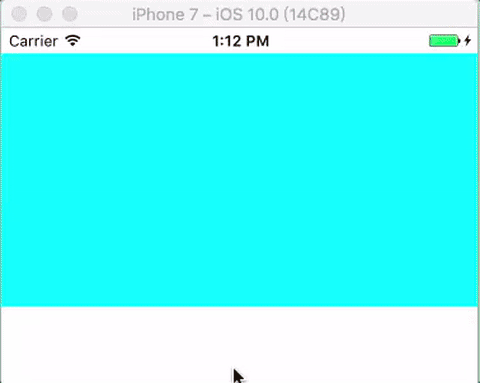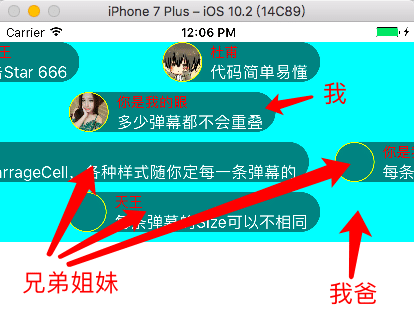前言
此弹幕来源于直播,所以名为 LiveBarrage 。
弹幕效果:

弹幕君说:
- 我会飞~~~(gun~,你咋不上天!!);
- 我的大小你做主;
- 我飞的速度你来定,让我飞多快我飞多快(PS:恩!真听话);
- 我的衣服你来买(弹幕样式自定义);
- 我们弹幕家族自带磁场从来不会叠加碰撞的哦(⊙o⊙);
- 你点我我就告诉你你点的是我而不是我爸(superView)也不会是我的兄弟姐妹 O(∩_∩)O~:

- 直播弹幕 ** ZBLiveBarrage ** 最懂你!!
目录结构:

技术剖析:
这里只分析弹幕实现具体逻辑,详细代码请下载项目根据以下分析理解。
-
插入弹幕到数组
通过函数- (void)insertBarrages:(NSArray <ZBLiveBarrageCell *> *)barrages
向实例ZBLiveBarrage的dadaArray属性添加ZBLiveBarrageCell弹幕数组。 -
创建弹幕
- (void)creatBarrage
{
if (self.dataArray.firstObject) {
// 取出弹幕数组里第一条未展示的弹幕
ZBLiveBarrageCell *barrageView = self.dataArray.firstObject;
// 通过 函数 zb_canBarrageSendInTheChannel 判断这条弹幕是否有可用跑道让其展示
NSInteger row = [self zb_canBarrageSendInTheChannel:barrageView];
// 若果有可用跑到
if (row >= 0) {
barrageView 开始执行 animateWithDuration 在 当前跑道 row 展示弹幕
}
}
// 再次执行 creatBarrage 方法
[self performSelector:@selector(creatBarrage) withObject:nil afterDelay:0.1f];
}
- 判断最新弹幕是否有可用跑道让其展示
channelArray与channelCount是对应的,channelCount是外界用来设置弹幕轨道数的属性,channelArray是用来存放每条轨道上最后一条弹幕,如果没有弹幕经过轨道默认赋值NSNumber实例。
- (NSInteger)zb_canBarrageSendInTheChannel:(ZBLiveBarrageCell *)newBarrage
{
// 遍历轨道数组
for (id object in _channelArray) {
if ([object isKindOfClass:[NSNumber class]]) {
// 如果最后一条没有最后一条弹幕,返回当前跑到
return row;
}else if ([object isKindOfClass:[ZBLiveBarrageCell class]]) {
// 获取最后一条弹幕
ZBLiveBarrageCell *oldBarrage = (ZBLiveBarrageCell*)object;
// 通过 zb_canBarrageSendInTheChannel: newBullet: 函数 实现新弹幕与当前跑道上最后一条弹幕的 碰撞检测
if ([self zb_canBarrageSendInTheChannel:oldBarrage newBullet:newBarrage]) {
return row;
}
}
}
return -1;
}
- 碰撞检测
- (BOOL)zb_canBarrageSendInTheChannel:(ZBLiveBarrageCell *)oldBarrage newBullet:(ZBLiveBarrageCell *)newBarrage
返回值为 BOOL 是否有可能碰撞,思路:我们暂且称当前轨道最后一条弹幕为【老弹幕】,将要展示的弹幕为【新弹幕】
if (【老弹幕】还没完全显示在屏幕中) {
return NO;
}else if (【老弹幕】的宽度为 0 时) {
// 刚刚添加的控件,有可能取到frame的值全为0,也要返回NO
return NO;
} else if (如果【老弹幕】与【新弹幕】的展示时间相同 && 【老弹幕】的宽度 > 【新弹幕】的宽度) {
// 比较弹幕的宽度(也就是比较速度),如果弹幕在屏幕中停留的时间都一样,【新弹幕】宽度小于【老弹幕】就是永远追不上上一条弹幕,返回YES
return YES;
} else {
// time为新弹幕从出现到屏幕最左边的时间(此时弹幕整体都在屏幕内,并不是弹幕消失的时间)
CGFloat time = 屏幕宽度/(屏幕宽度+【新弹幕】的宽度)*【新弹幕】的展示时间;
// endX为此时老弹幕的frame的x值
CGFloat endX = 【老弹幕】的 x - time/(【老弹幕展示时间】)*(屏幕宽度 + 【新弹幕】的宽度);
if (endX < -【新弹幕】的宽度) {
// 若此时老弹幕已经完全从屏幕中消失,返回YES
return YES;
}
}
return NO;
}
- 弹幕点击事件
因为视图在动画过程中不能响应手势,所以只能通过计算来响应用户的手势点击事件
- (void)touchesBegan:(NSSet<UITouch *> *)touches withEvent:(UIEvent *)event
{
UITouch *touch = [touches anyObject];
CGPoint clickPoint = [touch locationInView:self];
for (ZBLiveBarrageCell *barrageView in [self subviews])
{
if ([barrageView.layer.presentationLayer hitTest:clickPoint])
{
// 来到这里说明此条弹幕被点击
}
break;
}
}
}
- 代理事件
/**
* 弹幕点击事件回调
*/
- (void)zb_barrageView:(ZBLiveBarrage *)barrageView didSelectedCell:(ZBLiveBarrageCell *)cell;
/**
* 当前插入的弹幕模型数组全部展示完成回调
*/
- (void)zb_barrageViewCompletedCurrentAnimations;
/**
* 弹幕即将显示时回调
*/
- (void)zb_barrageView:(ZBLiveBarrage *)barrageView willDisplayCell:(ZBLiveBarrageCell *)cell;
/**
* 弹幕显示完成回调
*/
- (void)zb_barrageView:(ZBLiveBarrage *)barrageView didEndDisplayingCell:(ZBLiveBarrageCell *)cell;
小结
这一套弹幕实现核心代码在于弹幕碰撞监测那部分,是不是很简单那?
注释很详细的 Demo 点击这里
软件在能够复用前必须先能用。
——Ralph Johnson
内容来源于网络如有侵权请私信删除
文章来源: 博客园
- 还没有人评论,欢迎说说您的想法!

 客服
客服


